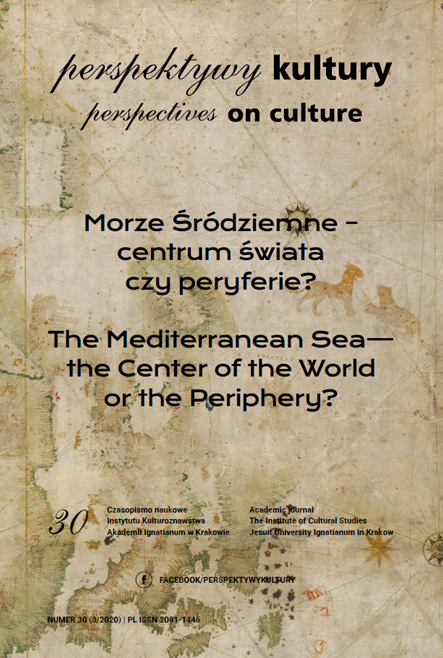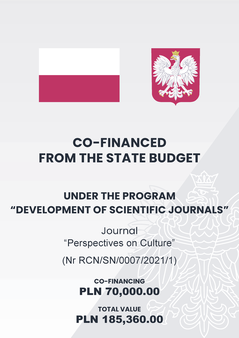The Influence of Mediterranean Culture on Polish Cuisine in the Middle Ages and the Early Modern Era
Abstract
The article explores the Mediterranean influences on Polish cuisine in the centuries that followed the adoption of Christianity at the end of the 10th century. This memorable act brought Poland into the circle of Western culture anchored in the Greco-Roman tradition, which also heavily impacted the everyday life of representatives of all strata of Polish society. The author draws attention to the variety of such contact, which includes the journeys of clergymen, diplomatic missions, and trips of young people to universities. Trade and economic exchange, as well as the activity of Italian merchants and craftsmen on the Vistula, also had a strong bearing on the refashioning of the culinary culture. The breakthrough moment was the arrival in Krakow in 1518 of Bona Sforza—who became the wife of the Polish king Sigismund I—and her many courtiers.
References
Allen, G. (2015). Sausage. A Global History. London: Reaktion Books.
Barszcz, L. (2005). Andrzej Krzycki. Poeta – dyplomata – prymas. Gniezno: Officina TUM.
Barycz, H. (1965). Spojrzenia w przeszłość polsko-włoską. Wrocław: Zakład Narodowy im. Ossolińskich.
Besala, J. (2015). Alkoholowe dzieje Polski. Czasy Piastów i Rzeczypospolitej szlacheckiej. Poznań: Wydawnictwo Zysk i S-ka.
Bystroń, J. (1933). Dzieje obyczajów w dawnej Polsce, v. 1. Warsaw: Trzaska, Evert i Michalski.
Cantù, C. (Ed.) (1859). Grande illustrazione del Lombardo-Veneto ossia sto¬ria delle città, dei borghi, comuni, castelli ecc. fino ai tempi moderni, v. 4. Milano: Società editrice A. Tranquillo Ronchi.
Carter, F.W. (1994). Trade and Urban Development in Poland. An economic geography of Cracow, from its origins to 1795. Cambridge: Cambridge Uni¬versity Press.
Cavaciocchi, S. (Ed.) (1997). Alimentazione e nutrizione, secc. XIII-XVIII, Atti della ventottesima Settimana di studi, 22-27 aprile 1996. Firenze: Le Monnier.
Czerniecki, S. (2009). Compendium ferculorum albo zebranie potraw. In: J. Dumanowski, M. Spychaj (Eds.), Monumenta Poloniae Culinaria, v. 1. Warsaw: Muzeum–Pałac w Wilanowie.
Dembinska, M. (1999). Food and Drink in Medieval Poland. Rediscovering a Cuisine of the Past. Philadelphia: University of Pennsilvania Press.
Dobosz, K. (2017). Santa Piva ora pro nobis czyli piwne zwyczaje średniowiecznej Polski. Historia i Świat, 6, 281–284.
Frandsen, K.-E. (2004). The Scale and Politics of Danzig’s Salted Herring Trade in the Late Sixteenth Century. International Journal of Maritime History, 16/2, 145–167.
Garnsey, P. (1999). Food and Society in Classical Antiquity. Cambridge: Cambridge University Press.
Golemo, K. (2010). Obraz Polski i Polaków we Włoszech. Poglądy, oceny, opinie. Krakow: Wydawnictwo Uniwersytetu Jagiellońskiego.
Grimm, V. (1996). From Feasting to Fasting, the Evolution of a Sin. Attutudes to Food in Late Antiquity. London – New York: Routledge.
Hryszko, R. (2004). Z Genui nad Morze Czarne. Z kart genueńskiej obecności gospodarczej na północno-zachodnich wybrzeżach Morza Czarnego u schyłku średniowiecza. Krakow: “Historia Iagellonica”.
Lirski, A. (2007). Wybrane informacje o karpiu i historii jego chowu na zie¬miach polskich. In: A. Lirski, A.K. Siwicki, & J. Wolnicki (Eds.), Wybrane zagadnienia dobrostanu karpia (pp. 11–12). Olsztyn: Wydawnictwo IRS.
Małowist, M. (1947). Kaffa. Kolonia genueńeska na Krymie i problem wschodni w latach 1435–1475. Warsaw: Towarzystwo Miłośników Historii.
Pociecha, W. (1949a). Królowa Bona (1494–1557). Czasy i ludzie Odrodzenia, v. 1. Poznań: Poznańskie Towarzystwo Nauk.
Pociecha, W. (1949b). Królowa Bona (1494–1557). Czasy i ludzie Odrodzenia, v. 2. Poznań Poznańskie Towarzystwo Nauk.
Petroni, G. (1835). Storia di Bari, v. 1. Napoli: Stamperia e Cartiere del Fibreno.
Sada, S. (1980). L’arte culinaria barese al celebre banchettò nudale di Bona Sforza nel 1517. In: B. Bliński (Ed.), La Regina Bona Sforza tra Puglia e Polonia (pp. 41–61). Atti del convegno, Bari 27 aprile 1980Accademia Polacca di Roma, Conferenze 95, 1987.
Smołucha, J. (2016). Kulturowe znaczenie enoturystyki we włoskim regionie Wenecja Euganejska. In: H. Kaczmarek (Ed.), Problemy turystyki i rek¬reacji (pp. 54–55), v. 6. Szczecin.
Smołucha, J. (2019). Le circostanze del viaggio di Bona Sforza da Bari a Cracovia. In: V. Parisi (Ed.), Per il quinto centenario dell’arrivo in Polonia di Bona Sforza d’Aragona, Atti del convegno (pp. 31–41). Roma 2018, Acca¬demia Polacca di Roma, Conferenze 144.
Szczucki, L. (1997). Humanizm włoski i kultura polska. Kultura i Społeczeństwo, 41/1, 37–47.
Weiss Adamson, M. (2002). The Greco-Roman World. In: M. Weiss Adamson (Ed.), Regional Cuisines of Medieval Europe (pp. 2–13). New York – Lon¬don: Routledge.
Copyright (c) 2020 Jesuit University Ignatianum in Krakow

This work is licensed under a Creative Commons Attribution-NoDerivatives 4.0 International License.
Autor, zgłaszając swój artykuł, wyraża zgodę na korzystanie przez Wydawnictwo Uniwersystet Ignatianum z utworu na następujących polach eksploatacji:
- utrwalania utworu w formie papierowej, a także na nośniku cyfrowym lub magnetycznym;
- zwielokrotnienia utworu dowolną techniką, bez ograniczenia ilości wydań i liczby egzemplarzy;
- rozpowszechniania utworu i jego zwielokrotnionych egzemplarzy na jakimkolwiek nośniku, w tym wprowadzenia do obrotu, sprzedaży, użyczenia, najmu;
- wprowadzenia utworu do pamięci komputera;
- rozpowszechniania utworu w sieciach informatycznych, w tym w sieci Internet;
- publicznego wykonania, wystawienia, wyświetlenia, odtworzenia oraz nadawania i reemitowania, a także publicznego udostępniania utworu w taki sposób, aby każdy mógł mieć do niego dostęp w miejscu i czasie przez siebie wybranym.
Wydawca zobowiązuje się szanować osobiste prawa autorskie do utworu.






